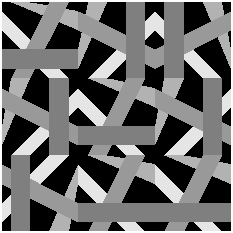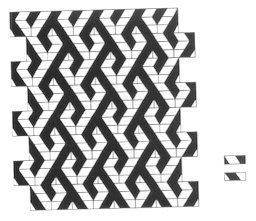|
VISUAL MATHEMATICS SLAVIK V. JABLAN Name: Slavik V. Jablan, Mathematician, (b. Sarajevo, Yugoslavia, 1952). Address: The Mathematical Institute, Knez Mihailova, P.O. Box 367, 11001 Belgrade, Yugoslavia. E-mail: jablans@mi.sanu.ac.yu Fields of interest: Geometry, mathematical crystallography, (ornamental arts, ethnomathematics, anthropology). Awards: CEVISAMA’87, Valencia, Spain. Publications: A
New Method of Generating Plane Groups of Simple and Multiple Antisymmetry,
Acta Cryst., A42 (1986), 209-212; A New Method of Deriving and Cataloguing
Simple and Multiple G3l Space Groups, Acta Cryst.,
A43 (1987), 326-337; Algebra of Antisymmetric Characteristics, Publ.
Inst. Math., 47(61) (1990), 39-55; Mackay Groups, Acta Cryst.,
A49 (1993), 132-137; Theory of Symmetry and Ornament, Math. Inst.,
Beograd, 1995.
Abstract: The development
of "visual mathematics" is considered in the historical context. The principle
of modularity is used for the construction of different plane structures
and reconstruction of ornaments.
1 VISUAL MATHEMATICS Throughout history, there existed permanent links between geometry and the visual arts, painting, sculpture, and architecture, so that visual representations were often the basis for geometric investigations. We may refer to the ornamental art or to the descriptive geometry discovered by Renaissance painters. More recently, after the introduction of non-Euclidean geometry, visualization of new mathematical structures became their most comprehensive models. The visual modeling of structures belonging to the field of natural sciences (Physics, Chemistry, Biology, etc.) by means of different visual representations - diagrams, graphics, etc. - brought into being a complete visual language for the expression and representation of mathematical structures. In the last few decades, thanks to computers, we have a new field of art/science connections: the visual mathematics. Many of the structures known only to mathematicians, or even by them considered as "exceptions" or "monsters" (e.g., fractals), are now visually represented. For the first time, we can see real-time animated images from the hyperbolic space, rotate knots or links in the screen of our computer, or make the 3D models of different topological surfaces. Unfortunately, most of the electronic
mathematical journals that could be found on the Web are, in fact, just
the classical mathematical journals in the electronic form, without using
any of the new visual possibilities. We are very proud that Visual Mathematics
(or VM https://members.tripod.com/vismath/
or http://www.mi.sanu.ac.yu/vismath/),
the electronic journal of ISIS-Symmetry, is probably the unique on-line
journal having both components: visual and mathematical. The main goal
of VM is to show the beauty of mathematics in a broad artistic-scientific
context. As a secondary aim, VM tries to correct the negative tendency
that led to the unpopularity of mathematics in school and the lack of public
understanding of this field.
2 MODULAR STRUCTURES Modularity is the use of several basic elements (modules) for constructing a large collection of different possible (modular) structures. In science, the modularity principle is represented by the search for basic elements (e.g., elementary particles, prototiles for different geometric structures, etc.). In art, different modules (e.g., bricks in architecture or in ornamental brickwork, etc.) occur as the basis of modular structures. In various fields of (discrete) mathematics, the important problem is the recognition of some set of basic elements, construction rules, and a (exhaustive) derivation of different structures that can be generated in the given framework. In a general sense, the modularity principle is a manifestation of the universal principle of economy in nature: the possibility for diversity and variability of structures, resulting from some finite and very restricted set of basic elements by their recombination. In all such cases, the most important step is the first choice (recognition or discovery) of the basic elements. This is shown by examples from ornamental art, where some elements originating from Paleolithic or Neolithic art are preserved till now, as a kind of "ornamental archetypes". In many cases, the derivation of discrete modular structures is based on symmetry. Using the theory of symmetry and its generalizations (simple and multiple antisymmetry, colored symmetry, etc.) for certain structures, it is possible to define exhaustive derivation algorithms, and even to obtain some combinatorial formula for their enumeration. Various examples for modular structures that are lying on the border between art and mathematics will be considered: a) antisymmetry ornaments and their derivation with a few prototiles, as well as the algorithmic approach to their generation (OpTiles); b) different knot-projections occurring in knotwork designs (Islamic, Celtic, etc.), derived from regular and uniform plane tessellations by using a few basic elements (KnotTiles); c) sets of modular elements for the derivation of possible and impossible objects (tribar, etc.) and the classification of the obtained structures (SpaceTiles). It is interesting that many of the
modular geometrical structures originate from the prehistoric or ancient
art, or from the ethnical art, and sometimes the same structures are discovered
completely independently by different cultures, distant one from another
in space and time. This is an important argument proving that the algorithmic
way of thinking is a universal property of mankind, and not only the characteristic
of the present epoch or culture, caused by the technological development.
Single prototile and knotwork tiling created
from it.
Anasazi pattern and its modular reconstruction. After showing some representative examples from VisMath, in the second part of the lecture several modular structures (OrnTiles, SpaceTiles, KnotTiles) will be presented, which were created by the author. All of them have very interesting historical backgrounds (e.g., OpTiles are inspired by Paleolithic and Neolithic key-patterns, SpaceTiles are modular elements for creating impossible figures, KnotTiles are the elements for creating mirror-curves). In the same time, using the principle of modularity, these structures could be used in order to explain the origins of the same or similar patterns occurring in different cultures, distant in space and time, as well as for the modular reconstruction of such patterns from archeological artifacts, where only some parts or fragments are preserved. In a similar way, the concepts of
Mirror Curves and KnotTiles, which are resulting from them,
are connected with different knotwork structures occurring in ornamental
art, black-and-white designs, and mathematical objects (knots and links,
graphs, polyominoes, plane tilings, etc.). Such perfect singular curves,
which are generated by mirror-reflections, were discovered independently
by different cultures: their highlights are Celtic knotwork designs, Tamil
drawings, and Tchokwe sand designs. After recognizing their mathematical
basis, it is possible to consider them from the mathematical point of view
and to use them very efficiently in education. This way, visual-symbolic
structures of ornamental art could be used as comprehensive models of some
mathematical concepts (knots, regular graphs, etc.).
REFERENCES Visual Mathematics, http://members/tripod/com/vismath/ and http://www.mi.sanu.ac.yu/vismath/ Jablan, S. Modularity in Art, https://members.tripod.com/~modularity/cover.htm Jablan, S. Mirror Curves, https://members.tripod.com/~modularity/mirr.htm Jablan, S. Modular Games, http://www.nexusjournal.com/Crowe.html
|

